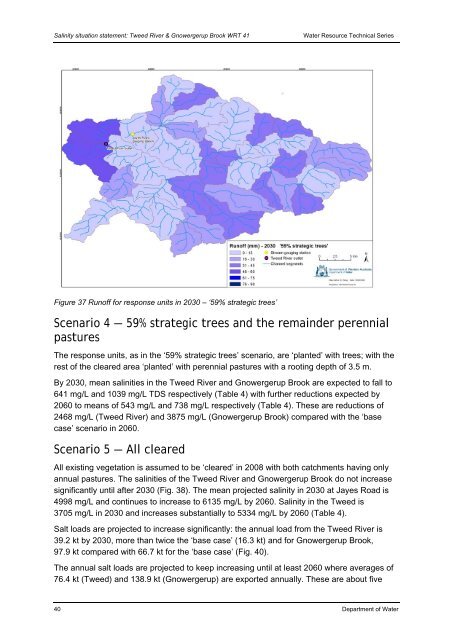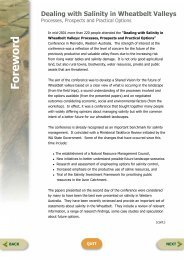Salinity situation statement Tweed River and Gnowergerup Brook
Salinity situation statement Tweed River and Gnowergerup Brook
Salinity situation statement Tweed River and Gnowergerup Brook
Create successful ePaper yourself
Turn your PDF publications into a flip-book with our unique Google optimized e-Paper software.
<strong>Salinity</strong> <strong>situation</strong> <strong>statement</strong>: <strong>Tweed</strong> <strong>River</strong> & <strong>Gnowergerup</strong> <strong>Brook</strong> WRT 41 Water Resource Technical Series<br />
Figure 37 Runoff for response units in 2030 – ‘59% strategic trees’<br />
Scenario 4 — 59% strategic trees <strong>and</strong> the remainder perennial<br />
pastures<br />
The response units, as in the ‘59% strategic trees’ scenario, are ‘planted’ with trees; with the<br />
rest of the cleared area ‘planted’ with perennial pastures with a rooting depth of 3.5 m.<br />
By 2030, mean salinities in the <strong>Tweed</strong> <strong>River</strong> <strong>and</strong> <strong>Gnowergerup</strong> <strong>Brook</strong> are expected to fall to<br />
641 mg/L <strong>and</strong> 1039 mg/L TDS respectively (Table 4) with further reductions expected by<br />
2060 to means of 543 mg/L <strong>and</strong> 738 mg/L respectively (Table 4). These are reductions of<br />
2468 mg/L (<strong>Tweed</strong> <strong>River</strong>) <strong>and</strong> 3875 mg/L (<strong>Gnowergerup</strong> <strong>Brook</strong>) compared with the ‘base<br />
case’ scenario in 2060.<br />
Scenario 5 — All cleared<br />
All existing vegetation is assumed to be ‘cleared’ in 2008 with both catchments having only<br />
annual pastures. The salinities of the <strong>Tweed</strong> <strong>River</strong> <strong>and</strong> <strong>Gnowergerup</strong> <strong>Brook</strong> do not increase<br />
significantly until after 2030 (Fig. 38). The mean projected salinity in 2030 at Jayes Road is<br />
4998 mg/L <strong>and</strong> continues to increase to 6135 mg/L by 2060. <strong>Salinity</strong> in the <strong>Tweed</strong> is<br />
3705 mg/L in 2030 <strong>and</strong> increases substantially to 5334 mg/L by 2060 (Table 4).<br />
Salt loads are projected to increase significantly: the annual load from the <strong>Tweed</strong> <strong>River</strong> is<br />
39.2 kt by 2030, more than twice the ‘base case’ (16.3 kt) <strong>and</strong> for <strong>Gnowergerup</strong> <strong>Brook</strong>,<br />
97.9 kt compared with 66.7 kt for the ‘base case’ (Fig. 40).<br />
The annual salt loads are projected to keep increasing until at least 2060 where averages of<br />
76.4 kt (<strong>Tweed</strong>) <strong>and</strong> 138.9 kt (<strong>Gnowergerup</strong>) are exported annually. These are about five<br />
40 Department of Water













